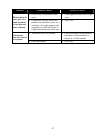
4-1
GF14 and GF40 SERIES GAS FRYERS
CHAPTER 4: PREVENTIVE MAINTENANCE AND
OPERATOR TROUBLESHOOTING
4.1 Daily Checks and Services
Inspect Fryer and Accessories for Damage
Look for loose or frayed wires, leaks, foreign material in frypot or inside cabinet, and any other
indications that the fryer and accessories are not ready and safe for operation.
Inspect the burner deflectors or targets to verify that each is positioned directly above its orifice, and
that the flame ignites approximately 2½ inches (60mm) above the orifice. The flame should strike
the center of the deflector and be a rich blue color. Call your Factory Authorized Service Center
(FASC) if you see any problems.
Clean Fryer Cabinet Inside and Out
Clean inside the fryer cabinet with dry, clean cloth. Wipe all accessible metal surfaces and
components to remove accumulations of oil or shortening and dust.
Clean the outside of the fryer cabinet with a clean, damp cloth soaked with dishwashing detergent,
removing oil/shortening, dust, and lint from the fryer cabinet.
DANGER
Never attempt to clean the fryer during the cooking process or when the frypot is
filled with hot oil/shortening. If water comes in contact with oil/shortening heated to
cooking temperature, it can cause the oil/shortening to splatter and severely burn
nearby personnel.
Filter Cooking Oil/Shortening
The cooking oil/shortening used in your fryer should be filtered at least twice every day (more often
if the fryer is in constant use). Refer to Section 3.6, “Draining and Filtering”, for details.
4.2 Quarterly Checks and Services
Drain and Clean Frypot
During normal usage of your fryer, a deposit of carbonized cooking oil or shortening will gradually
form on the inside of the frypot. This deposit must be periodically removed to maintain your fryer’s
efficiency.
Follow the procedures for draining the frypot in Section 3.6, the follow the “Boiling Out the Frypot”
procedures in Section 3.2.


















